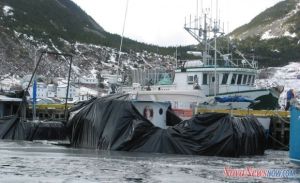
In Nova Scotia, ship owners wrapped their boats in plastic and flushed fresh water through to try to kill the invasive Violet Tunicate that was fouling their hulls.
What’s True: crusty fouling organisms and invasive species
There are lots of fouling organisms–things that grow to cover ship bottoms, pilings, underwater equipment. Some are soft like certain kinds of algae, others are large and hard like mussels and oysters, and still others are crusty like the Fouling in the book. Bryozoans are like that, and there are many species of Bryozoans alive today. In the book, the Fouling turned out to be something scientists thought was extinct.
When a new species arrives in an area, it can take over, crowd out the native environment and reak havoc. That’s what the Fouling does. Not all non-native species, introduced from somewhere else reak havoc, but when they do, they are called invasive species. They are very real, and they are a problem around the world.
What’s Fiction: The Fouling in the book
As it exists in the book, the Fouling is imaginary, pieced together from bits of reality. Nothing in nature is known to grow as rapidly as the Fouling. A crusty fouling organism has not crept up the coast of the United States and shut down ports. It certainly has not grown so quickly as to sink ships at sea.
What’s a bit of both?
The Fouling was something the scientists thought was extinct. There are things that look like Bryozoa that have long been extinct. Herellid’s for example: When scientists first saw the fossils, they thought they were Bryozoa.
Different varieties of tiny crusting organisms like the Fouling can be distinguished by the branching pattern they make when they build their little crusty tubes. Let’s keep using Bryozoa as an example because that’s what the author had in mind. Not only can you tell different varieties by their branching patterns, but whole species and Orders can be differentiated by the patterns of their tubes. When scientists first saw fossil Herellids, they thought they were Bryozoa until they looked at the branching patterns. It sounds a little drastic, but consider that we can tell an oak from a maple by the shape of the leaf.

You must be logged in to post a comment.